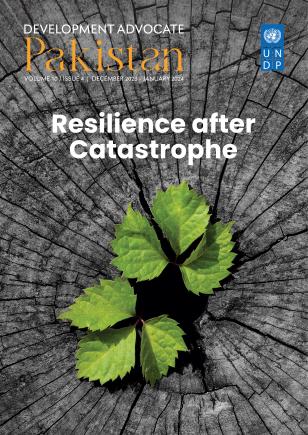Resilience after Catastrophe

Resilience after Catastrophe
January 22, 2024
A Rights-Based Approach to Resilience in Pakistan
In its simplest definition, resilience is the ability to flex but not break. Yet, we currently live in a world that is seemingly stretched to the breaking point or beyond, not least due to human activity (referring to UNDP’s 2020 Human Development Report, The Next Frontier – Human Development and the Anthropocene). Over the past 50 years, global climate and weather-related disasters have surged five-fold. The last 12 months have been the Earth’s hottest on record. Three times more people are displaced by disasters than war. At last year’s COP28, U.N. Secretary-General António Guterres emphatically stated: “We cannot keep kicking the can [of climate action] down the road. We are out of road.”
Pakistan ranks high in the global matrix of increased vulnerability, as well as frequency and intensity of disasters, both climate-induced and man-made. It is the 11th highest disaster risk-prone country out of 193. In South and South-West Asia, it faces the highest projected loss of Gross Domestic Product (9.1 per cent annually) due to climate change. The impact is disproportionately borne by the most vulnerable populations, including marginalized communities, women, children, farmers, and those residing in glacial terrain and low-lying coastal areas. This ominous analysis came to fruition when Pakistan experienced first-hand a devastating flood in 2022, which impacted 33 million people, displaced eight million, pushed 9 million people below the poverty line, and caused damages and economic losses of USD 30 billion and reconstruction needs of USD 16.3 billion. That is also why at COP28, Pakistan’s Caretaker Prime Minister, Anwaar-ul-Haq Kakar, called for quick operationalization of a Loss and Damage Fund for which Pakistan very successfully led the advocacy at COP27.
Pakistan has in place a commendable national climate change policy architecture. The Federal Ministry of Climate Change and Environmental Coordination (MoCC&EC) has adopted the UNDP-supported National Climate Change Policy and the Nationally Determined Contributions (NDCs). Approved by the Federal Cabinet, the MoCC&EC’s National Adaptation Plan provides an effective framework for partnerships and financing, including an estimate that the country requires USD 7-14 billion per year on climate change adaptation investments. Pakistan is also a pathfinder country for the Global Shield Against Climate Risks, is the first country in Asia to initiate the in-country process in November 2023 (led by MOCC&EC, supported by UNDP), and is modelling itself as an example for other countries seeking to strengthen their financing options for climate change resilience, including in the area of risk insurance.
Feedback Evaluation for DAP:
We are conducting a review of Development Advocate Pakistan in order to assess its impact. We request you to take out ten minutes from your valuable time and fill the online feedback evaluation form available at:

 Locations
Locations




